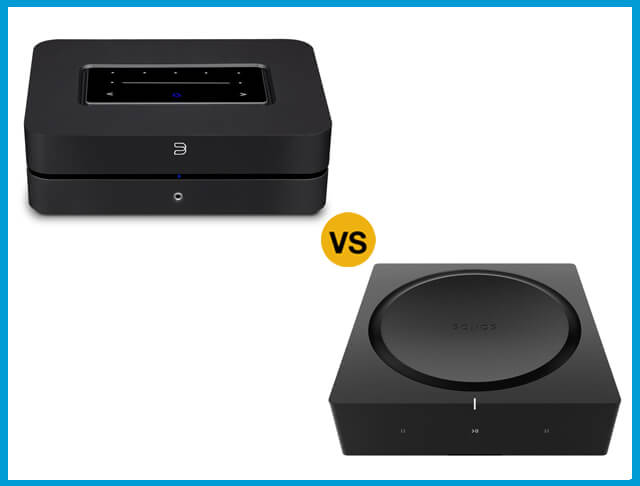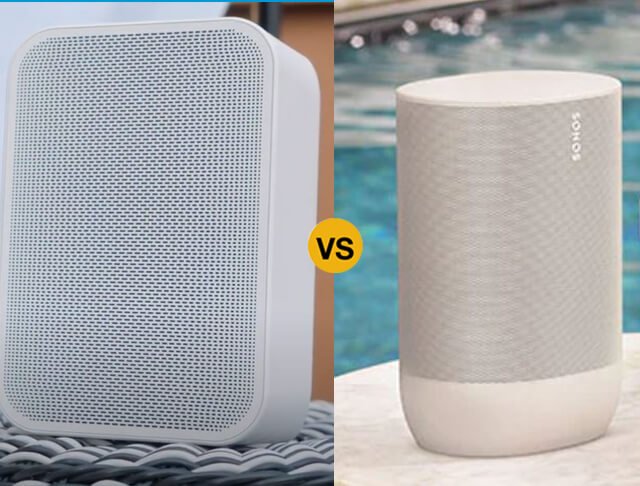Sonos has been on the top of the smart speakers’ market over the past few years now. Many competitors, including Google and other well-known brands, are trying to keep up with its pace by launching speakers with similar specifications.
Table could not be displayed.However, they lack somewhere or the other. We bet you didn’t miss the current news where Sonos sued Google for infringing his product’s audio patents. The judge ruled the same as well.
The closest competitor of Sonos these days is Bluesound. So should you ditch Sonos for Bluesound? Let’s find out the difference between their products in this Bluesound vs Sonos battle.
You may like: Audio Pro vs. Sonos
Bluesound Pulse Flex 2i vs. Sonos One
Connectivity: In terms of connectivity, Bluesound Pulse Flex 2i is a step ahead of Sonos One. Pulse Flex 2i has a Type A and Type B USB port at the back, 3.5mm aux output for headphones, digital input for optical cable, and a power bi-pin port. It is also enabled with Bluetooth 4.1, unlike Sonos One. It also has an Ethernet port that supports RJ45 and 100BaseT networks.
On the other hand, Sonos One just has an Ethernet port and a Join button at the back.
Smartness: when it comes to smartness, both of them are equally smart. Both support Alexa, Google Assistant, Airplay 2 and are controlled through their respective mobile apps.
The only difference is the voice assistants in Sonos One are inbuilt, wherein Bluesound, are optional.
Multi-room functionality: Was the king of multiroom functionality beaten? We guess not. Sonos allows an easy multi-room music experience. As it only requires one speaker to be in a wired connection and rest can stay connected in a group wirelessly through their own mesh network
In Bluesound, all the speakers have to individually be in a wired/wireless connection with your home Wi-Fi router.
Weight and looks: Sonos One is twice as heavier as Pulse Flex 2i. Also, the control panel of Pulse looks a bit more aesthetic when compared to Sonos One. Moreover, Bluesound has an IR sensor built-in for controls.
Bluesound Pulse Flex 2i vs Sonos Move
Sonos Move, as compared to Sonos One, has a powerful and enriching sound quality. This is one of the Sonos best-sounding smart speakers and thus is fit to use as an outdoor speaker as well. Another benefit of Sonos Move over Sonos One is that the former has Bluetooth enabled as well.
Connectivity: For connectivity, you will see a power button, join button, and USB C port for the power supply. It also comes with an indoor charging base. The battery backup runs up to 11 hours. It supports Bluetooth and Wi-Fi and has no Ethernet port.
Pulse Flex 2i has more connectivity ports that include 2 USB ports, ethernet port, Wi-Fi, Bluetooth, headphone jack, and optical in port.
Weight and looks: Again, Sonos Move (6.61lb) weights more than Bluesound Pulse Flex 2i (2.7lbs).
Bluesound Pulse Mini 2i vs Sonos Play 5
On the first look, it is difficult to distinguish between Pulse Mini 2i and Play 5. They look a lot similar until you find their control panel on top.
Connectivity: The Bluesound Pulse Mini 2i has similar connectivity specifications as Pulse flex 2i i.e., 2 USB ports, one headphone output, ethernet port, two-way Bluetooth, 3.5mm audio input, and optical input.
In-Play 5, you will find an Ethernet port, Join button, power supply port, and a 3.5mm headphone jack.
Sound quality: The Pulse Mini 2i is fitted with 2 woofers, 2 tweezers, and a sophisticated DSP engine. On the other hand, Sonos Play 5 is fitted with 3 tweezers, 3 mid-woofers, and six class D amplifiers.
Talking about the overall sound quality, it totally depends on the type of sound quality you like to prefer. Play 5 can be kept both in the vertical and horizontal position, whereas Mini 2i works in the horizontal position only.
However, it is being said that Pulse Flex 2i has a better sound than Mini 2i. Play 5 sound quality has more clarity, hits low and high frequencies rightly, and works neutral in tone.
Bluesound Pulse soundbar vs Sonos Arc
These are the soundbars from the respective brands.
Connectivity: in terms of connectivity, the Pulse soundbar still beats Sonos Arc.
In the Pulse soundbar, you will find an HDMI cable, optical cable, and also stereo RCA to RCA cable that allows you to connect to an old TV easily as well. The HDMI port supports ARC and eARC. Besides, there are usually 2 USB ports, an Ethernet port, an output port for subwoofers, Bluetooth, and Wi-Fi.
In Sonos Arc, you will find HDMI (Arc and eArc), optical audio port, Ethernet, Wi-Fi (no Bluetooth), and no RCA cable or port. However, it does have an IR receiver sensor to sync it with the TV remote. Arc also supports HDMI CEC, unlike Pulse soundbar.
Sound: Sonos Arc supports Dolby Atmos, Pulse soundbar does not. Sonos arc is fitted with 8 digital amplifiers, 8 elliptical woofers, 3 silk dome tweezers, Trueplay, and Sound Enhancement.
Bluesound pulse soundbar fitted with 2 tweezers, 2 woofers, 2 passive radiators, and 2 midrange drivers. Regardless to say, Bluesound favors easy connectivity. However, when it comes to sound quality, there is none like Sonos Arc.
Bluesound Pulse Soundbar vs Sonos Beam

Connectivity: To connect Sonos Beam to Tv, it should necessarily have an HDMI or optical output port. Beam has an ethernet port, HDMI, optical in, and Join button at the back.
The Pulse soundbar is flushed with every kind of connection possible. No doubt, it would be easy to connect pulse soundbar to TV than Sonos Beam (if your tv does not support HDMI or optical)
Sound: Sonos Beam is still powerful for its size. It is fitted with 4 woofers, one tweezer, 3 passive radiators, 5 digital amplifiers, and a far-field microphone. In totality, picking one in terms of sound quality is always difficult. But in conclusion, Bluesound has done a tremendous job to meet the Sonos sound quality bars. However, Sonos has this unique sound production, and Trueplay tuning allows you to adjust the sound according to room size.
Bluesound Node vs Sonos Port
Node and Port are streaming components from respective brands.
Connectivity: Will Sonos be able to beat Node in connectivity? Let’s see.
In Node, you will find one Ethernet port, one Lan/USB port, 1 HDMI eARC port, 2x RAC audio out, 1 x Subwoofer out, 1 coaxial cable out port, optical in/out port, IR in port, and power in port. It also supports Bluetooth, unlike Sonos Port.
In Sonos Port, 2 Ethernet port, optical digital out port, join button, audio line-in port (for Cd player, record player), audio line out port (for RAC cable, coaxial cable), and 12V trigger.
Node comes with more accessories as well.
Controls: Sonos Port has no control panel, whereas Node has a full-fledged control panel on top that allows to play/pause, increase volume, previous/next, and preset buttons.
Sound: If you have a Sonos ecosystem, it is advisable to prefer Sonos Port. If not, Bluesound Node has a better sound quality as it has a better DAC (Digital to analog converter). However, people find it difficult to use the BluOS app. Sonos controller apps are more intitutive. Also, with the Sonos S2 app, Port will be able to support hi-resolution audio (provided your speaker support S2 as well).
Bluesound Node 2i vs Sonos Connect
Sonos connect has been discontinued but is much similar to Sonos Port in its purpose and features.
Bluesound Node 2i is a successor of Bluesound Node wireless streamer. The main difference between the two is Node 2i includes a USB port instead of an HDMI eARC (found in Node at the same place).
Connectivity: Sonos Connect connectivity is similar to Sonos Port. It includes 2 Ethernet ports, optical audio out port, coaxial cable out port, analog audio in and out port (i.e. RCA).
On the other hand, at the rear of Node 2i, you will find one Ethernet port, one LAN/USB port, subwoofer RCA out, coaxial RCA out port, digital optical cable port out, IR in, optical in port, and also a USB C port. It supports Bluetooth, Wi-Fi, Alexa, Google Assistant, Airplay 2.
Bluesound users can use this to enjoy multi-room audio by connecting its speakers to it through the BlueOs app. It supports 32bit and 192KHz DCA.
Bluesound Powernode 2i vs Sonos Amp

Sonos Amp is Sonos wireless streaming amplifier, whereas Powernode 2i is Bluesound’s power-packed wireless streaming amplifier.
Connectivity: Both of the devices are full-fledged with multiple connectivity options.
Sonos Amp at rear back has 2 Ethernet ports, join button, subwoofer out RCA type, analog RCA output, speaker output connections, HDMI Arc input, 100 streaming channels, Airplay 2, and more.
Powernode 2i has one Ethernet port, HDMI eARC input, two 3.5mm stereo output, subwoofer out RCA, USB type a port, IR in, 3.5mm stereo out, 4 speaker terminals, Bluetooth, Wi-Fi, Alexa, and others.
Both include a control panel on top.
Sound: Bluesound amplifier is known for its DAC and hi-resolution sound, and it certainly doesn’t disappoint in the same. Bluesound did a good job keeping up with the Sonos quality. However, that doesn’t mean Sonos Arc is any bad. Not just Sonos speakers, Arc is capable of supporting any speaker as well.
Bluesound Pulse Sub vs Sonos Sub
So Pulse SUB and Sonos SUB are wireless subwoofers from the respective brands. Subwoofers are used along with soundbars to elevate the sound quality even more. It is usually used in a surround sound setup.
Compatibility: at the back of the Bluesound sub, there is an Ethernet port, USB type A and Type B port, analog input port, and more. It has volume buttons on the side.
Sonos sub has an Ethernet port, power supply, and Join button. There are no other control buttons on the device.
Sound quality: Bluesound Pulse SUB has a class D amplifier, Acoustic design with a woofer, and LFE setting.
Sonos SUB has 2 class D amplifiers, two force canceling drivers on the inner side facing each other for powerful bass, dual acoustic ports, 25Hz low frequency, Trueplay, and adjustable EQ.
For a person who is not a big audiophile, it would be difficult for someone to tell things apart. Both sound equally good. In terms of convenience, Pulse SUB can be used both wirelessly and wired. On the other hand, Sonos SUB is strictly wireless. Moreover, Bluesound SUB can work with other speakers and soundbars as well.

Further reading: What Are The Best Optical Cables For Sonos?
FAQs on bluesound vs sonos:
Does Bluesound work with Sonos?
Being each other rivals, it is unlikely that Bluesound will work with Sonos wirelessly. They can work with Sonos through a workaround though you cannot guarantee the same sound quality.
Can Bluesound stream to Sonos?
Yes, you can use Bluesound streaming devices like Node with Sonos speakers connecting them digitally (not wirelessly).
Is Sonos better than Bluesound?
In terms of connectivity, it is Bluesound over Sonos. In terms of sound quality, Sonos over Bluesound.
Is it possible to add Bluesound speakers to a Sonos system?
No, you can’t add Bluesound speakers to the Sonos system through the Sonos app or via Wi-Fi.
Can you combine Bluesound and Sonos?
It depends on what device you are to combine with Sonos. Bluesound wireless streamer works well with Sonos smart speaker setup.


